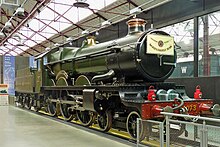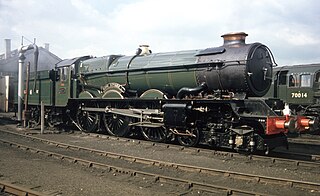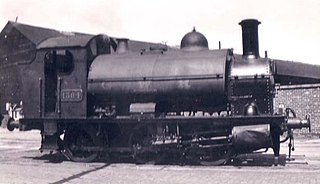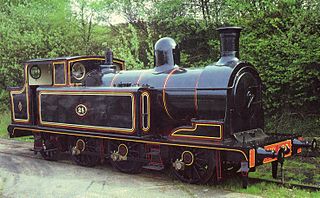
Caerphilly Castle is a member of the GWR 4073 Class built in August 1923.

Caerphilly Castle is a member of the GWR 4073 Class built in August 1923.
The lead locomotive of its class, after a brief period of running-in service, between April and October 1924, the locomotive was exhibited at the British Empire Exhibition, which was held at Wembley Park, Wembley, north-west London. [1] Its first shed allocation was Old Oak Common. Its August 1950 shed allocation was Bath Road, Bristol. Its last shed allocation was Cardiff Canton in March 1959.
Withdrawn in May 1960, it was made part of the National Collection. Refurbished for display purposes at Swindon Works, on 2 June 1961 she was formally handed over by Dr Richard Beeching at Paddington Station to the director of the Science Museum. Pickfords hauled the engine from Park Royal Goods Depot to the museum in Kensington, using Scammell Constructor units on Sunday 4 June. [2] [3] She was then placed on display in the new land transport gallery.

After the Science Museum decided to refurbish the gallery into the Making the Modern World, [4] it was decided to move the locomotive to Swindon Steam Railway Museum. After a period on display at National Railway Museum, York, she moved to Swindon on the museum's opening.

The Great Western Railway 4000 or Star were a class of 4-cylinder 4-6-0 passenger steam locomotives designed by George Jackson Churchward for the Great Western Railway (GWR) in 1906 and introduced from early 1907. The prototype was built as a 4-4-2 Atlantic. They proved to be a successful design which handled the heaviest long-distance express trains, reaching top speeds of 90 mph (145 km/h), and established the design principles for GWR 4-cylinder classes over the next twenty-five years.

The 4073 or Castle Class are 4-6-0 steam locomotives of the Great Western Railway, built between 1923 and 1950. They were designed by the railway's Chief Mechanical Engineer, Charles Collett, for working the company's express passenger trains. They could reach speeds of up to 100 mph (160 km/h).

The Great Bear, number 111, was a locomotive of the Great Western Railway. It was the first 4-6-2 (Pacific) locomotive used on a railway in Great Britain, and the only one of its type built by the GWR.

George Jackson Churchward was an English railway engineer, and was chief mechanical engineer of the Great Western Railway (GWR) in the United Kingdom from 1902 to 1922.

BR Standard Class 9F number 92220 Evening Star is a preserved British steam locomotive completed in 1960. It was the last steam locomotive to be built by British Railways. It was the only British main line steam locomotive earmarked for preservation from the date of construction. It was the 999th locomotive of the whole British Railways Standard range.

STEAM – Museum of the Great Western Railway, also known as Swindon Steam Railway Museum, is housed in part of the former railway works in Swindon, England – Wiltshire's 'railway town'. The 6,500-square-metre (70,000 sq ft) museum opened in 2000.

5051 Drysllwyn Castle is a Great Western Railway (GWR) Castle Class locomotive built at Swindon Works in May 1936 and named after Dryslwyn Castle. It is owned by the Didcot Railway Centre.

The Great Western Railway 3200 Class was a design of 4-4-0 steam locomotive for passenger train work. The nickname for this class, almost universally used at the time these engines were in service was Dukedog since the locomotives were composed of former Duke Class boilers on Bulldog Class frames. As such they were one of the last standard gauge steam locomotive classes to retain outside frames.

GWR 4073 "Castle" Class No. 4079 Pendennis Castle is a 4-6-0 steam locomotive built in 1924 for the Great Western Railway (GWR) at Swindon Works to a design of Charles Collett. It was employed on long-distance express passenger trains on the GWR and its successor, British Railways' Western Region.

The GWR 1400 Class is a class of steam locomotive designed by the Great Western Railway for branch line passenger work. It was originally classified as the 4800 Class when introduced in 1932, and renumbered in 1946.

The Great Western Railway (GWR) 6000 Class or King Class is a class of 4-6-0 steam locomotives designed for express passenger work and introduced in 1927. They were the largest locomotives built by the GWR, apart from the unique Pacific. The class was named after kings of the United Kingdom and of England, beginning with the then reigning monarch, King George V, and going back through history. They handled the principal GWR expresses on the main line from London to the West of England and on the Chiltern line to Birmingham and Wolverhampton, until 1962 when the class was withdrawn.

The 1361 Class were small 0-6-0ST steam locomotives built by the Great Western Railway at their Swindon Works, England, mainly for shunting in docks and other sidings where track curvature was too tight for large locomotives.

The Great Western Railway (GWR) 1366 Class is a class of 0-6-0 pannier tank steam locomotives built in 1934. They were a useful design and because of their light weight and short wheelbase and were often used on dockside branches or other lines with sharp curvatures.

The GWR 5600 Class is a class of 0-6-2T steam locomotive built between 1924 and 1928. They were designed by Charles Collett for the Great Western Railway (GWR), and were introduced into traffic in 1924. After the 1923 grouping, Swindon inherited a large and variable collection of locomotives from historic Welsh railway companies, which did not fit into their standardisation programme. GWR boiler inspectors arrived en masse and either condemned the original locomotives or had them rebuilt. The systematic destruction of many examples of locomotives, most still in serviceable condition, followed, but various were worked alongside 5600 Class.

The Great Western Railway (GWR) 4700 Class was a class of nine 2-8-0 steam locomotives, designed by George Jackson Churchward. They were introduced in 1919 for heavy mixed-traffic work. Although primarily designed for fast freight, the class also sometimes hauled passenger trains, notably heavy holiday expresses in the summer months. They were unofficially nicknamed "Night Owls" because they were primarily designed to haul goods during the night and they could be seen simmering in the daylight, awaiting their nocturnal duties.

The GWR 4073 Class 5043 Earl of Mount Edgcumbe is a steam locomotive of the GWR 'Castle' Class, built in March 1936. It was originally named Barbury Castle, and was renamed Earl of Mount Edgcumbe in September 1937. It had a double chimney and 4 row superheater fitted in October 1958.

GWR 4073 Class 5080 Defiant is a GWR 4073 Class steam locomotive built for the Great Western Railway at Swindon Works in May 1939. It was originally named Ogmore Castle.

GWR 4073 Class No. 7029 Clun Castle is a 4-6-0 steam locomotive built at Swindon Works in May 1950 to a design by Charles Collett for operation on the Western Region of British Railways. It was named after Clun Castle in Shropshire.
Number 7028 Cadbury Castle was a Great Western Railway 4073 Castle class 4-6-0 steam locomotive built at the former GWR Swindon Works on 19 May 1950. The Castle Class locomotives were built as express passenger locomotives on the GWR. The Castle Class locomotives were to replace the earlier 4000 Star class locomotives. They were designed by the railway's Chief Mechanical Engineer, Charles Collett. Cadbury Castle cost £10,546 and an extra £1,094 for her Hawksworth tender.

The Taff Vale Railway (TVR) O1 class is a class consisting of fourteen 0-6-2T steam tank locomotives, designed by Tom Hurry Riches, which were introduced to the TVR during the period 1894-1897.